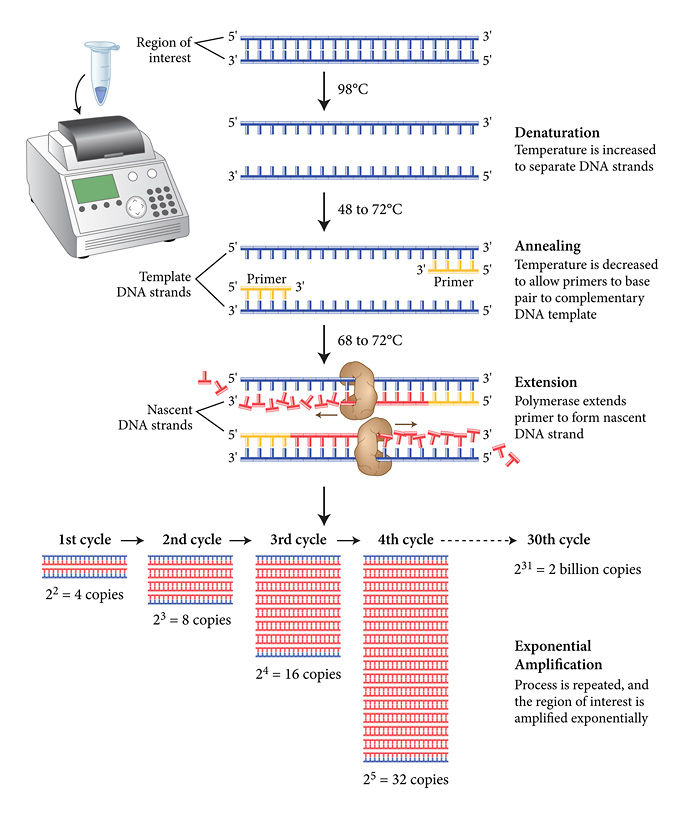
Master Mixes

OneTaq®,Q5 ® Quick-Load®, LongAmp® and NEBNext® are registered trademarks of New England Biolabs, Inc.
Phusion® was developed by Finnzymes Oy, now a part of Thermo Fisher Scientific. This product is manufactured by New England Biolabs, Inc. under agreement with, and under the performance specifications of Thermo Fisher Scientific.
Choose Type:
- Protocol for OneTaq 2X Master Mix with GC Buffer (M0483)
- Protocol for OneTaq Hot Start Quick-Load 2X Master Mix with Standard Buffer (M0488)
- OneTaq® Quick-Load® 2X Master Mix with GC Buffer (M0487)
- PCR Protocol for LongAmp® Hot Start Taq DNA Polymerase (M0534)
- Protocol for Phusion® Hot Start Flex 2X Master Mix
- Protocol for Q5® Hot Start High-Fidelity 2X Master Mix
- Protocol for LongAmp™ Taq 2X Master Mix
- Protocol for OneTaq® 2X Master Mix with Standard Buffer (M0482)
- Protocol for OneTaq Hot Start Quick-Load 2X Master Mix with GC Buffer
- Protocol Phusion® High-Fidelity PCR Master Mix with HF Buffer
- Protocol for OneTaq Hot Start 2X Master Mix with GC Buffer (M0485)
- Protocol for OneTaq Hot Start 2X Master Mix with Standard Buffer (M0484)
- Guidelines for PCR Optimization with OneTaq® and OneTaq® Hot Start DNA Polymerases
- Protocol for OneTaq® Quick-Load 2X Master Mix with Standard Buffer (M0486)
- Multiplex PCR Guidelines for Multiplex PCR 5X Master Mix
- Protocol for Phusion® High-Fidelity PCR Master Mix with GC Buffer
- Protocol for Quick-Load® Taq 2X Master Mix
- Protocol for Taq 2X Master Mix (M0270)
- Protocol for Taq 5X Master Mix (M0285)
- Quick Protocol for Multiplex PCR 5X Master Mix
- Protocol for a PCR reaction using Hot Start Taq 2X Master Mix (M0496)
- Protocol for LongAmp™ Hot Start Taq 2X Master Mix
- Optimizing Restriction Endonuclease Reactions
- Protocol for Q5® High-Fidelity 2X Master Mix
- Protocol for a PCR reaction using NEBNext® Q5® Hot Start HiFi PCR Master Mix (M0543)
- Protocol for Direct Digestion of gDNA during droplet digital PCR (ddPCR)
-
Understanding Variability in DNA Amplification Reactions
-
DNA Damage - the major cause of missing pieces from the DNA puzzle
-
Anatomy of a Polymerase - How Function and Structure are Related
Read about the relationship between Polymerase structure and function when copying DNA.
- PCR Reagents Brochure
- DNA Polymerase Selection Chart
- PCR Troubleshooting Guide
- Taq PCR Kit Troubleshooting Guide
- DNA Damage and PreCR
- Guidelines for PCR Optimization with Taq DNA Polymerase
- Guidelines for PCR Optimization with Thermophilic DNA Polymerases
Feature Articles
Brochures
Selection Tools
Troubleshooting Guides
Usage Guidelines
Several factors govern which polymerase should be used in a given application, including:
Removal of existing nucleotides: Will the nucleotide(s) be removed from the existing polynucleotide chain as part of the protocol? If so, will they be removed from the 5´ or the 3´ end?
Thermal stability: Does the polymerase need to survive incubation at high temperature or is heat inactivation desirable?
Fidelity: Will subsequent sequence analysis or expression depend on the fidelity of the synthesized products?
Products and content are covered by one or more patents, trademarks and/or copyrights owned or controlled by New England Biolabs, Inc (NEB). The use of trademark symbols does not necessarily indicate that the name is trademarked in the country where it is being read; it indicates where the content was originally developed. The use of this product may require the buyer to obtain additional third-party intellectual property rights for certain applications. For more information, please email busdev@neb.com.
This product is intended for research purposes only. This product is not intended to be used for therapeutic or diagnostic purposes in humans or animals.



